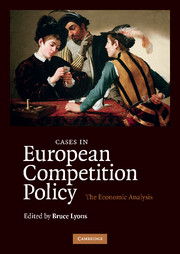Book contents
- Frontmatter
- Contents
- Contents by potentially anticompetitive business practices
- Contents by markets
- List of figures
- List of tables
- List of contributors
- Preface
- Introduction: the transformation of competition policy in Europe
- A Anticompetitive behaviour by firms with market power
- B Agreements between firms
- Introduction
- B.1 Cartels
- B.2 Other horizontal agreements
- B.3 Vertical agreements
- 9 Efficiency enhancing or anticompetitive vertical restraints? Selective and exclusive car distribution in Europe
- 10 Beer – the ties that bind
- 11 Parallel trade of prescription medicines: the Glaxo Dual Pricing case
- C Mergers
- Bibliography
- Index
9 - Efficiency enhancing or anticompetitive vertical restraints? Selective and exclusive car distribution in Europe
Published online by Cambridge University Press: 05 June 2012
- Frontmatter
- Contents
- Contents by potentially anticompetitive business practices
- Contents by markets
- List of figures
- List of tables
- List of contributors
- Preface
- Introduction: the transformation of competition policy in Europe
- A Anticompetitive behaviour by firms with market power
- B Agreements between firms
- Introduction
- B.1 Cartels
- B.2 Other horizontal agreements
- B.3 Vertical agreements
- 9 Efficiency enhancing or anticompetitive vertical restraints? Selective and exclusive car distribution in Europe
- 10 Beer – the ties that bind
- 11 Parallel trade of prescription medicines: the Glaxo Dual Pricing case
- C Mergers
- Bibliography
- Index
Summary
Introduction
Vertical agreements between the European car manufacturers and their dealers have existed since the emergence of the industry. They have been claimed to be necessary for an efficient distribution, though they also raise concerns about enhancing market power. One main vertical restraint has been selective distribution. This enables manufacturers to impose various criteria on their dealers, such as tying of sales and after-sales services, and to prohibit sales to independent resellers. A second main restraint has been exclusive distribution, through which manufacturers can assign an exclusive territory to their dealers. A third main restraint has been exclusive dealing (or the non-compete obligation), allowing manufacturers to prohibit dealers from selling multiple competing brands.
These restraints were initially allowed as individual exemptions under Article 81 of the EC Treaty. From 1985 they became institutionalised as a block exemption, applicable to the whole car sector. The exemption was very formalistic on which types of agreements were acceptable, so that in practice a standardised distribution system emerged, with all manufacturers adopting essentially the same selective and exclusive distribution agreements. After minor revisions in 1995, more drastic reforms took place in 2002. The European Commission aimed to adopt a more economic approach and give the manufacturers more freedom of choice between alternative distribution forms (hence avoiding the ‘straitjacket effect’). At the same time, the Commission wanted to be stricter towards the manufacturers, because of a fear of ‘cumulative anticompetitive effects’ if all manufacturers adopt the same or similar vertical restraints.
- Type
- Chapter
- Information
- Cases in European Competition PolicyThe Economic Analysis, pp. 219 - 244Publisher: Cambridge University PressPrint publication year: 2009
- 3
- Cited by



